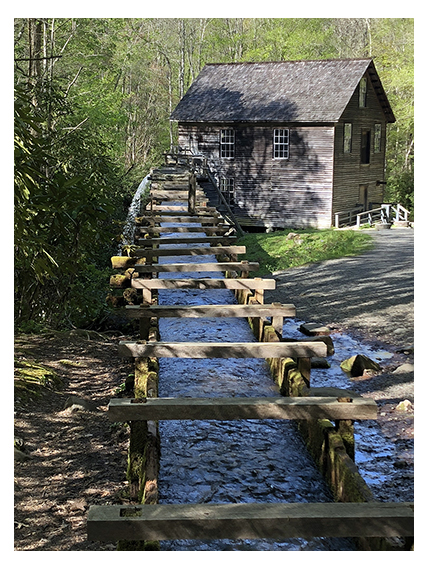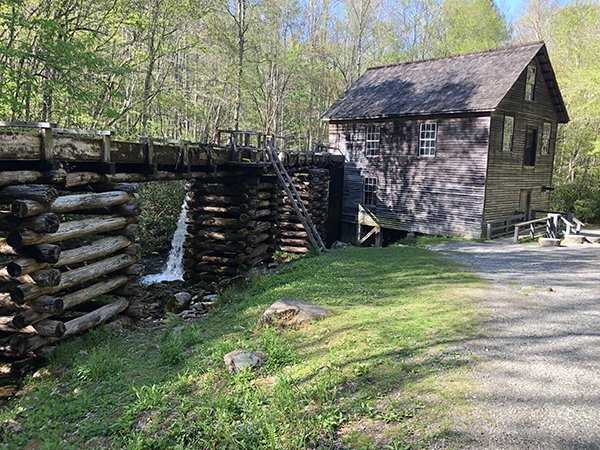
Mingus Mill in Great Smoky Mountains National Park
The Mingus Mill we see today is nestled among trees, but, in its heyday, the mill was surrounded by cleared fields and crops. Although the Mingus family, who moved into the Oconaluftee Valley in the 1790s, probably built an earlier mill on this site. The present structure was completed in 1886. The family paid $600 to millwright contractor Sion Thomas Early to build the mill in three months. The mill's distinction was its metal turbine, an improvement on the traditional wooden waterwheel that made Mingus Mill one of the most advanced in the Smokies.
 Mill Days
Mill DaysMill Days were usually Saturdays. During winter, the open floor of Mingus Mill was crowded with customers. When the weather was warm, customers gathered outside, one person telling that his daughter-in-law finally has her baby, another making a deal to trade chickens for a nearly new axe head. Barter was an important currency of rural life, although people paid cash for kerosene, sugar, coffee, cloth, and other items. Those with no money bartered their services; sewing, construction labor, etc.
At a time when generations mixed more, children and adults enjoyed socializing at the mill. The Dutch door at the front of Mingus Mill let in air and light but prevented children and their dogs from running in and out. A woodstove in one corner kept the miller and his customers warm in winter. At the back third of the building, millstones for corn and flour sit atop a raised platform with a short set of stairs leading to each.
Mingus Mill was also the largest mill in the Smokies, serving about 200 families, with customers coming from as far as 15 miles away. Usually it was the men who rode to the mill, but, if they were too busy with farm work, they might send a youngster
Millers rarely asked widows to pay the grain toll. Everyone else, however, deposited one-eighth of the grain they brought to mill (approximately a gallon per bushel) into a large toll box. The miller could keep his toll grain or sell it to others, usually as flour or cornmeal.

Above images by Jeaneane Payne. @ 2025
A person heading downstream along Mingus Creek would first see the low dam that funnels water from the creek into the millrace. Millraces direct water to the mill's waterwheel or, in this case, the turbine. Lined with rot-resistant hemlock, the four foot wide millrace is fitted with a water gate to regulate the flow.
The millrace channels water into the 200 foot long wooden flume that rides high atop a bridge of log cribbing. A water gate on the flume regulates flow, a "chunk rack" holds back leaves, twigs, and other debris, and a box in the bottom of the flume catches sand that could ruin the turbine.
As the ground drops below it, the flume eventually stands 22 feet high where it meets the mill's penstock. Fit next to the back wall of the mill, the penstock is a four foot square, vertical wooden shaft filled with water from the flume. The penstock's 22 feet of constant water pressure creates enough force to produce 11 horsepower, a bragging amount for its time and comparable to the power of a small lawn tractor.
The housing for the turbine is a metal globe about two feet in diameter. Within spins a drum-shaped frame-fitted with angled blades. As the penstock water hits it, the ring of blades turns at a maximum of 400 revolutions per minute. This energy turns a metal rod that rises into the mill, turning the millstones and all other mechanical equipment to the mill.
Inside, the mill is airy and spacious. Its simple lines and plain face belie the careful attention to detail that Mr. Early put into his work. Of course, in those days, fine white dust from cornmeal and flour covered most surfaces.
Corn was ground on the spot and returned to the customer's sack. The miller could grind more than six bushels (about 350 pounds) per hour. Wheat, too, was ground for waiting customers or, for a small fee, customers could store wheat on the mill's third floor. The second floor of the mill was devoted to sifting meal and flour and to cleaning wheat.
Wheat kernels were dumped into a hopper on the ground floor and conveyed to the second floor in little cups attached to a pulley-driven belt. There the fan on a small smut machine blew chaff and dust off the wheat, expelling the trash to the outside via a duct. the clean wheat dropped back down to the first floor to be ground into flour. Both the belt and the smut machine were powered by the mill's water-driven turbine.
Although the corn stories were cut from Smoky Mountain granite, Mingus Mill's wheat stones are quartz buhrstones imported from France. The hard quartz held an edge longer and could shear the hull off wheat more cleanly than native stone.
Belts conveyed ground wheat back to the second floor where a chute fed the flour into a bolting chest. A finely crafted wooden box, the chest stands eight feet high, eight feet wide, and twenty feet long. Essentially, it is a long sifter, producing four grades of flour.
Hours: 9:00 AM - 5:00 PM daily mid-March through mid-November. Also, open Thanksgiving weekend.
Driving Directions:
From Gatlinburg TN enter Great Smoky Mountains National Park at Sugarlands Visitor Center (2.6 miles from the Parkway in downtown Gatlinburg). Travel 30 miles on Hwy 441 (Newfound Gap Road) to Mingus Mill.
| WELCOME TO GREAT SMOKY MOUNTAINS NATIONAL PARK Trip Ideas Great Smoky Mountains Facts Policies Institute at Tremont Order Your Free Visitor's Guide Transportation & Airports Local News Photo Tours • Fall Photo Tour • Roaring Fork Motor Nature Trail • Smoky Mountain Fall Foliage • Fall Foliage at Clingmans Dome • Fall Colors in nearby Villages • Fall in Wears Valley • Best Fall Hikes in the Smokies |
WHAT TO DO Attractions Biking Fishing Hiking Outdoor Adventure Scenic Drives and Rides Shopping Heritage, History, & Culture Nature Activities |
WHERE TO STAY Bed & Breakfast Cabins Camping Condos Hotels WHERE TO EAT |
4 SEASONS Winter Spring Summer Fall WEDDINGS Wedding Services Honeymoon Cabins |
Surrounding Towns: • Cherokee • Gatlinburg • Maggie Valley • Pigeon Forge • Townsend • Wears Valley CONTACT Contact Add Your Site Advertise |
© 1996-2025 by Image Builders | Privacy Policy